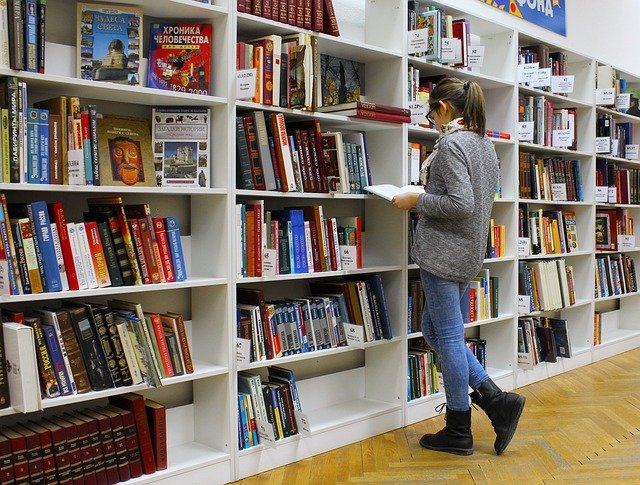Sign up for our daily edtech news briefing today, free.
Libraries are often the hub of the school with a flurry of activity throughout the day. With the new modern media center designs, these spaces are designed to spark innovation, build a sense of community and provide areas for students and staff to collaborate, connect, and recharge. The coronavirus pandemic does not have to change the welcoming, community focus of a modern media center — but it certainly presents some challenges.
As schools cautiously reopen the doors of their physical buildings, minimizing risk from COVID-19 to students and staff is top priority and that includes the library. Adapting media center spaces to ensure that school communities remain safe, while also still functioning as a future-ready library, is possible with just a few intentional design solutions.
Spacing for physical distance
As schools return to face-to-face learning and physical buildings begin to reopen, it is critical to think of strategies for “physical distancing” that still offer opportunity for students to collaborate and engage with each other.
Creating space to physical distance will be a key element to safely returning to school. In the library, that may require a few short-term shifts in design and current space utilization. Consider the following questions to potentially open up additional space:
- Are there extra shelving units that could be temporarily removed to free floor space?
- Are there empty rooms in the school that may be underutilized that could become additional space for collections? Underutilized common spaces within the school could host shelving for resources and materials that are often showcased in the media center.
- Has the collection been recently weeded and/or are there less circulated materials that can be temporarily removed or rotated to open up space?
Thinking creatively to allow more room for students and staff will translate into meaningful experiences within media center spaces that still fit the guidelines for safety and physical distancing.
Traffic flow
Physical distancing protocols should extend to directing foot traffic flows within the media center to create a safely-shared space. Direct foot traffic flows by clearly identifying a separate exit and entrance and adding floor markings to designate traffic patterns. Using brightly colored floor tape and signage may encourage students and staff to further respect physical distancing.
Shift bookcases and furniture to allow space between aisles, especially if you have very long aisles. As people, we are creatures of habit, so friendly reminders to follow signage and traffic patterns from staff will help to ensure success. Students may also need to learn to wait for an aisle to be free from classmates before entering the aisle, so they can safely share the space.
The circulation desk is usually buzzing with activity from both students and staff. If the book return is next to the circulation desk, consider a new location that will mitigate additional traffic. Creative floor decals surrounding the circulation desk may be useful to indicate proper spacing.
Flexible furniture
Flexible furniture that can easily move and reconfigure enables libraries to not only shift design for physical distancing, but adapt to support additional functions for emergency situations. Media centers across the nation continue to reimagine their services to include curbside pick-up and even food distribution when called upon in an emergency.
Rethink the furniture layouts to create smaller personal spaces, additional workstation spaces and more open space for traffic flow. Strategically arrange furnishings as suggested below for additional physical distancing:
- Separate mobile tables into individual or smaller group workspaces.
- Remove a few chairs at the table to encourage physical distancing.
- Utilize whiteboards for dividers between workspaces.
- Separate lounge furniture to individual areas around the media center.
- Shift mobile shelving units for one-way traffic flow and to create barriers to spaces.
- Limit chairs in conference rooms.
- Utilize perimeters for work surfaces that face away from the aisles and provide a place for access to power.
To accommodate the shrinking occupancy in the media center, schools may consider utilizing outdoor spaces or common areas to offer additional spaces for students and staff to work, learn and connect.
Technology
Technology is front and center now more than ever — from supporting e-learning with digital collections and resources to rethinking the use of technology in the library. Highlighted below are three strategies to adapt the utilization of technology within library spaces that can ensure that our school communities remain safe and resilient in the face of COVID-19 protocols:
- Create individual computer stations around the media center or hood computers that are too closely spaced.
- Shift desktops for laptops distributed via a kiosk or circulation desk that will allow for cleaning between uses and promote social distancing by dispersing users throughout the space.
- Implement touchless self-checkout stations to minimize the number of touchpoints between students and staff.
With a few shifts in the management and implementation of technology, the library can remain a safe, healthy central hub of information, learning, and culture in school. By implementing strategic design principles and health-minded practices in the best interests of students and staff, libraries can remain welcoming spaces that provide a beacon of hope in which we can see a better future.
Dr. Christina Counts, VP of Strategy and Development for MiEN Company, is a proven leader with a successful background in transforming learning spaces to modern engaging learning environments. Dr. Counts has worked in education for over 17 years with experience as a classroom teacher, district instructional leader, school administrator, and digital and innovative learning designer.
Like this article? Sign up for our Edtech news briefing to get news like this in your inbox, or check out all of SmartBrief’s education newsletters, covering career and technical education, educational leadership, math education and more.
More from SmartBrief Education:
- Free resources for educators during the coronavirus pandemic
- Distance learning while respecting students’ home lives
- 8 ways to make vocabulary instruction more effective
